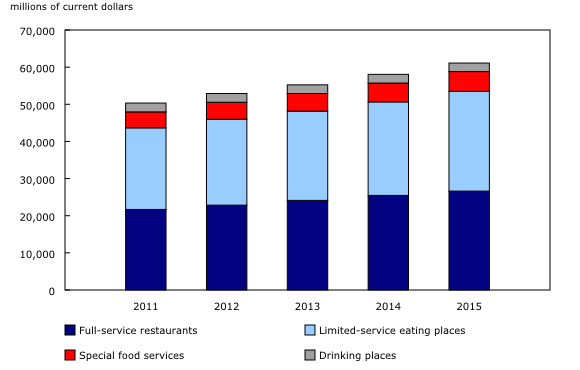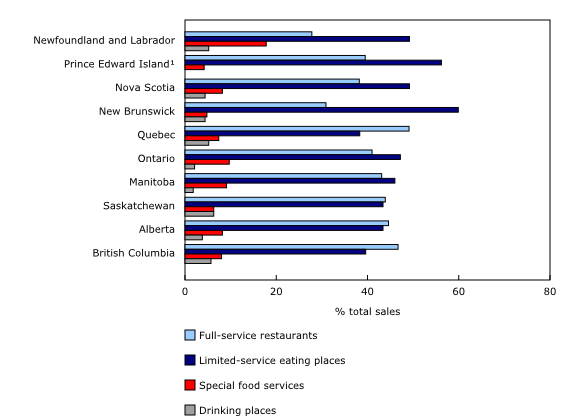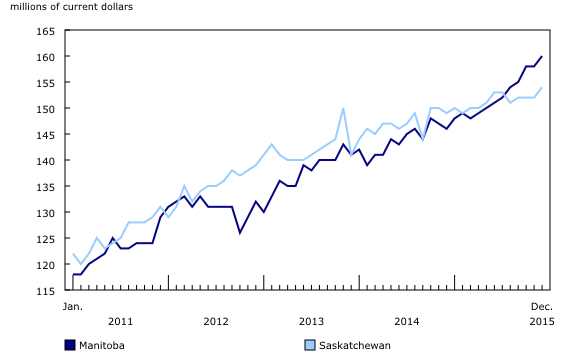Highlights of food service and drinking places, 2015
Archived Content
Information identified as archived is provided for reference, research or recordkeeping purposes. It is not subject to the Government of Canada Web Standards and has not been altered or updated since it was archived. Please "contact us" to request a format other than those available.
Released: 2016-12-12
National overview
The total sales of the food services and drinking places subsector rose 5.2% from 2014 to over $61.1 billion in 2015. These sales mainly came from the receipts for food and beverages in each of the component industries, and reflected both higher prices and increased volume. According to the Consumer Price Index, prices for food purchased at restaurants grew by 2.8% in 2015, while alcoholic beverages served in licensed establishments rose 1.5%.
The annual growth rate for food services and drinking places in 2015 was the largest since 2006, just above the 5.1% posted in 2014. Over the five-year period beginning in 2011, sales in the food services and drinking places subsector gained on average 4.6% a year, roughly double the annual average price increase for food in restaurants (+2.3%) and alcoholic beverages (+2.0%).
The food services and drinking places subsector includes four components. Sales in the subsector were dominated by the full-service restaurant and limited-service eating places industries, with each accounting for about 44% of the total in 2015. Limited-service restaurants had slightly higher sales in 2011, 2012 and 2015 while the full-service restaurants posted higher sales in 2013 and 2014.
The special food services industry group, which includes food service contractors, caterers and mobile food services, contributed 8.7% to total sales in 2015. The drinking places industry group accounted for the remaining 3.7%. Prior to 2011, sales at drinking places accounted for over 5% of the total.
The majority of sales for the subsector came from Ontario (39.5%), Quebec (18.2%), British Columbia (15.5% of sales) and Alberta (14.5%). Quebec has seen its share of sales decline over the past five years.
Food services and drinking places in the Canadian economy
Restaurants Canada, an industry trade group representing commercial food services businesses, reports that restaurants average 18 million visits per day. In 2015, food services and drinking places accounted for 1.5% of Canada's gross domestic product (GDP), and the GDP of the subsector has grown faster than the Canadian economy as a whole over the past four years. The largest relative gain came in 2015, when the subsector grew by 2.6%, almost three times faster than the Canadian economy (+0.9%) as a whole that year.
On the consumption side, food and beverage services accounted for 5.9% of household expenditure in Canada in 2015, a share that has changed little since 2011.
The number of employees in the food services and drinking places subsector rose 3.1% in 2015 to an average 1.0 million people and accounted for 6.6% of all employees in Canada according to the Survey of Employment, Payroll and Hours. These employees, however, are earning less money than employees in any other subsector, averaging $344 per week or just over one-third the national average ($952 per week).
One reason for this is that the accommodation and food service sector relies more on part-time workers than any other sector of the economy. According to the Labour Force Survey, 44.8% of employment in the sector was considered part time in 2015, and 44.4% of all employees in the sector earned less than $12 an hour. As the largest sub-component of this sector, the food services and drinking places subsector is correspondingly reliant on part-time labour, a situation that contributes to the low weekly average earnings.
Strong restaurant sales drive the growth
In 2015, sales in the limited-service eating places industry gained the most in dollar terms, rising 6.7% to $26.9 billion. Sales in the full-service restaurant industry posted the next largest gain, up 4.5% to $26.6 billion. This marked the slowest growth rate for sales at full-service restaurants since 2011.
The relative size of these two industries varied across the country. In Atlantic Canada, the limited-service industry accounted for 53% of sales in the subsector, while the full-service industry accounted for 34%. In contrast, full-service restaurants accounted for a higher proportion of sales than did limited-service in Quebec (49% versus 38%) and British Columbia (47% versus 40%). In the remaining provinces, these two industries were more equal in size.
In the special food services industry group, sales rose 4.6% from a year earlier to over $5.3 billion in 2015. Sales in this industry group, which includes food service providers contracted by work camps, declined in Alberta (-5.6%) and Newfoundland and Labrador (-0.3%), but rose in every other province. This industry group accounted for the largest share of sales in Newfoundland and Labrador (17.8%), followed by Ontario (+9.7%).
The drinking places industry group was the smallest component of the subsector in 2015, with total sales down 2.1% from 2014 to $2.3 billion. Although sales in the drinking places industry rose 0.4% in 2014, sales in this industry have fallen in 9 of the previous 11 years. This was mostly a result of fewer businesses, as many have re-classified as full-service restaurants.
Ontario and British Columbia post largest gains
Ontario (+7.0%) and British Columbia (+6.8%), the first- and third-largest provinces in total sales, recorded the largest gains in dollar terms in 2015. Total sales in Ontario grew by 7.0% in 2015, with more than half of the increase coming from limited-service eating places (+8.1%). In British Columbia, sales at full-service restaurants (+6.8%) posted the largest dollar gain, followed closely by limited-service eating places (+8.0%).
Quebec (+3.3%) was one of four provinces posting a sales increase below the national average. Most of the gain came from limited-service eating places (71%), where sales were up 6.4% for the year. Full-service restaurants, the largest industry in the subsector in Quebec, rose 1.3%.
Strong sales in the Atlantic region
Total sales in the Atlantic region grew by 5.5% in 2015, on the strength of gains in the full-service industry (+8.9%). Sales at limited-service eating places rose 5.1% and remained dominant in the subsector.
Nova Scotia (+5.5%) posted the largest gain in total sales in the region in 2015, as well as the largest increase in prices paid at restaurants (+4.1%) of any province.
Every Atlantic province except New Brunswick had price gains above the national average for food purchased from restaurants.
Newfoundland and Labrador was the lone province in the region where sales growth was below the national average in 2015. However, Newfoundland and Labrador still had the largest percentage sales increase nationally from 2011 to 2015.
Manitoba posts largest sales increase on the Prairies
In August 2015, sales in Manitoba surpassed those in Saskatchewan as sales growth in Manitoba accelerated in the second half of the year. This brought Manitoba's total sales for 2015 ahead of Saskatchewan's for the first time since 2008. The limited-service industry, the full-service industry and the special food services industry group all contributed to the 6.1% gain in Manitoba.
Sales increased at half the rate in Saskatchewan (+3.0%), with limited-service eating places (+2.8%) and full-service restaurants (+2.3%) posting gains.
Alberta posted the smallest percentage sales increase for food services and drinking places in 2015, rising 1.7% to $8.9 billion.
Limited-service eating places sales in Alberta increased 0.4 percentage points from 2014 to 4.3%, while growth at full-service restaurants fell from 8.9% in 2014 to 0.9% in 2015. These gains were partially offset by lower sales in the special food services industry group (-5.7%). Sales in this group, which includes contractors that provide food services at work camps in the oil and gas sector, declined by $43 million—the largest decrease of any industry in any province.
The three territories reported a total sales increase of 5.7% in 2015. Sales in the Northwest Territories and Nunavut accounted for the gain, while there was a small decline in Yukon.
Note to readers
Full-service restaurants are dining places where customers order and are served when seated and pay after eating. They may be licensed to sell alcoholic beverages.
Limited-service eating places, also known as quick-service restaurants, are places where patrons make their orders at a counter or line and pay for the meal before eating.
Special food services includes three industries: food service contractors, caterers and mobile food services (food trucks and carts).
Drinking places, or bars or taverns, are primarily engaged in serving alcoholic beverages for consumption on the premises. They may also serve food, though it is not their primary source of revenue.
Contact information
For more information, or to enquire about the concepts, methods or data quality of this release, contact us (toll-free 1-800-263-1136; 514-283-8300; STATCAN.infostats-infostats.STATCAN@canada.ca) or Media Relations (613-951-4636; STATCAN.mediahotline-ligneinfomedias.STATCAN@canada.ca).
- Date modified:




